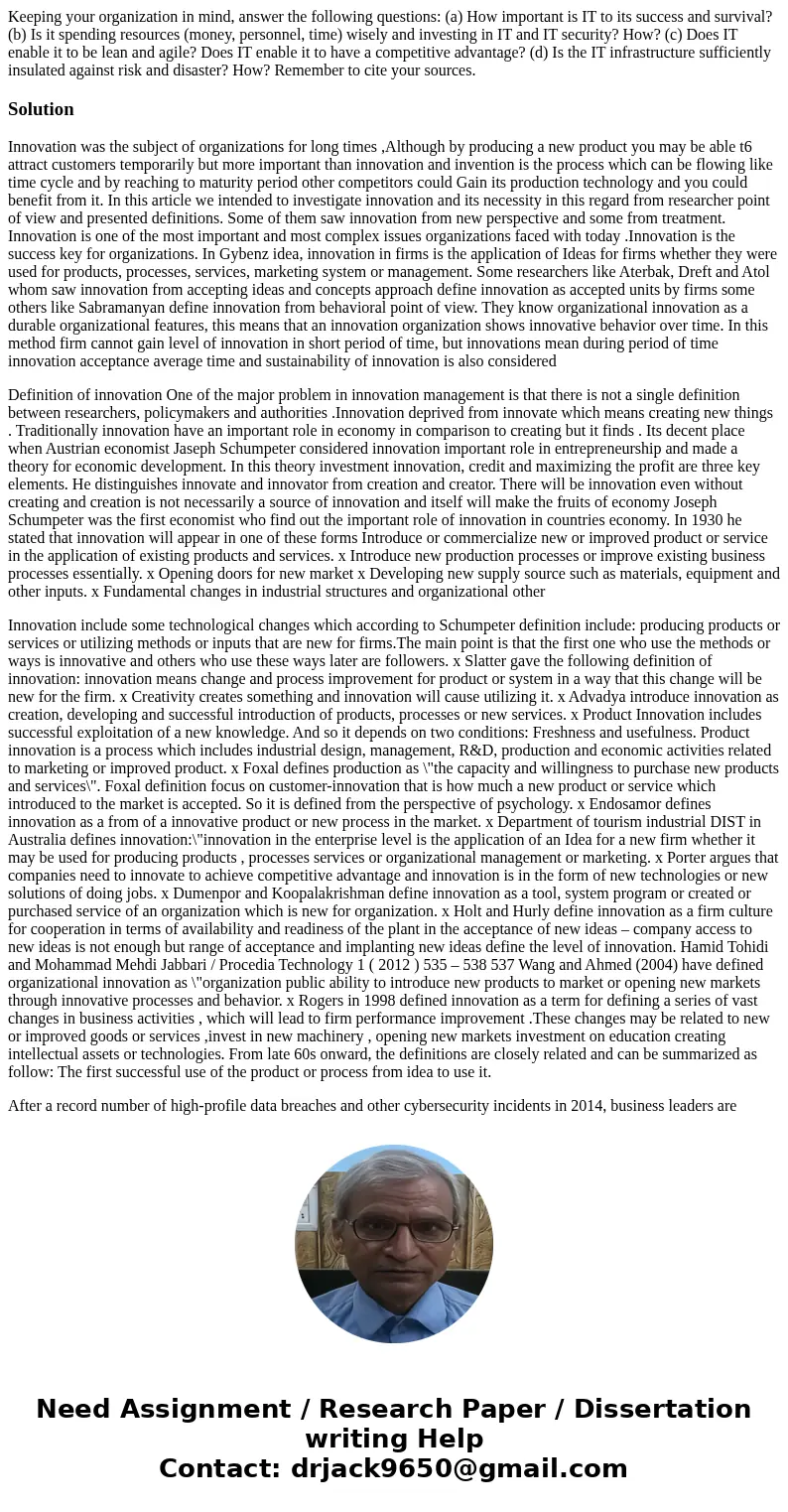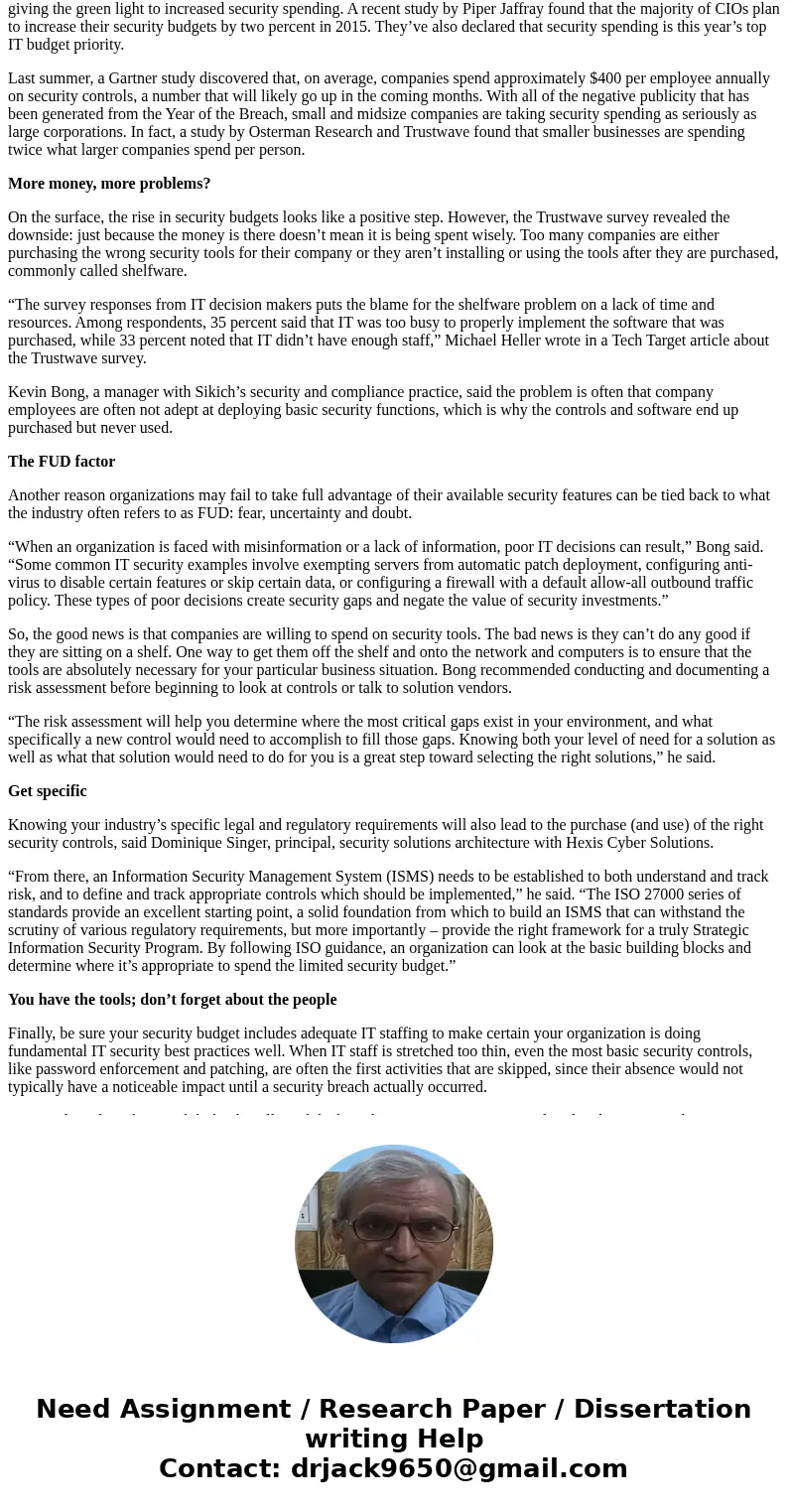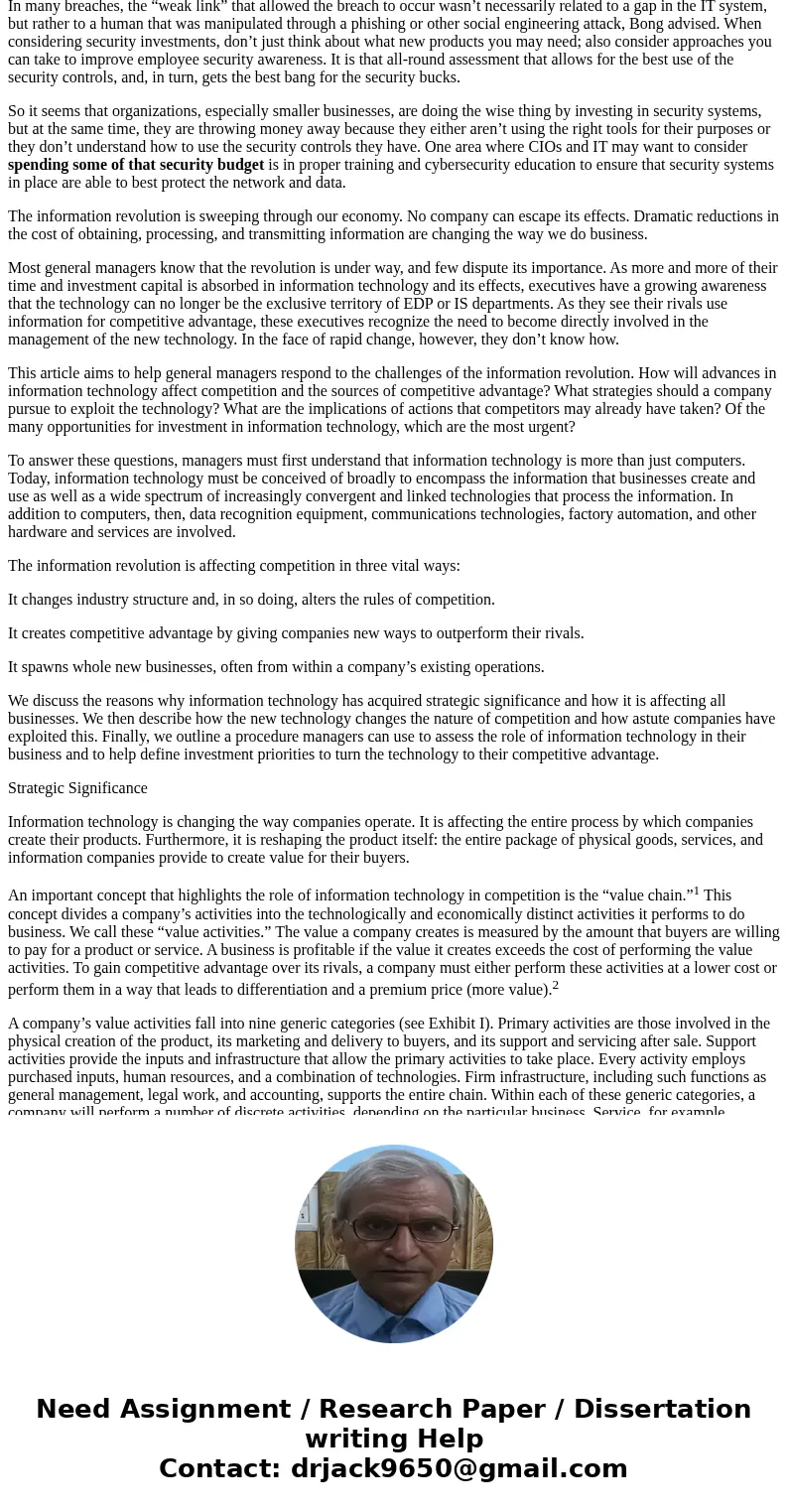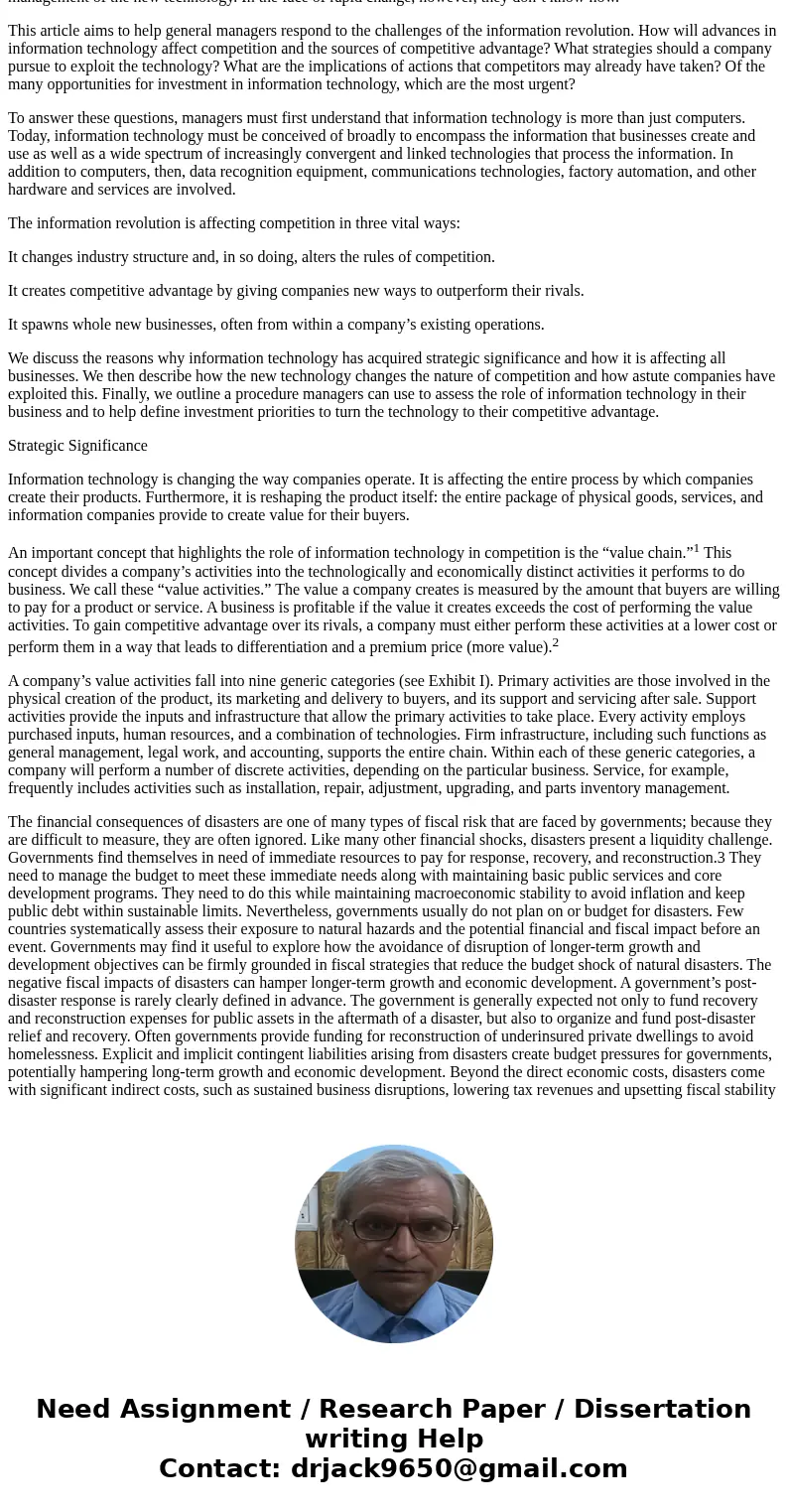Keeping your organization in mind answer the following quest
Keeping your organization in mind, answer the following questions: (a) How important is IT to its success and survival? (b) Is it spending resources (money, personnel, time) wisely and investing in IT and IT security? How? (c) Does IT enable it to be lean and agile? Does IT enable it to have a competitive advantage? (d) Is the IT infrastructure sufficiently insulated against risk and disaster? How? Remember to cite your sources.
Solution
Innovation was the subject of organizations for long times ,Although by producing a new product you may be able t6 attract customers temporarily but more important than innovation and invention is the process which can be flowing like time cycle and by reaching to maturity period other competitors could Gain its production technology and you could benefit from it. In this article we intended to investigate innovation and its necessity in this regard from researcher point of view and presented definitions. Some of them saw innovation from new perspective and some from treatment. Innovation is one of the most important and most complex issues organizations faced with today .Innovation is the success key for organizations. In Gybenz idea, innovation in firms is the application of Ideas for firms whether they were used for products, processes, services, marketing system or management. Some researchers like Aterbak, Dreft and Atol whom saw innovation from accepting ideas and concepts approach define innovation as accepted units by firms some others like Sabramanyan define innovation from behavioral point of view. They know organizational innovation as a durable organizational features, this means that an innovation organization shows innovative behavior over time. In this method firm cannot gain level of innovation in short period of time, but innovations mean during period of time innovation acceptance average time and sustainability of innovation is also considered
Definition of innovation One of the major problem in innovation management is that there is not a single definition between researchers, policymakers and authorities .Innovation deprived from innovate which means creating new things . Traditionally innovation have an important role in economy in comparison to creating but it finds . Its decent place when Austrian economist Jaseph Schumpeter considered innovation important role in entrepreneurship and made a theory for economic development. In this theory investment innovation, credit and maximizing the profit are three key elements. He distinguishes innovate and innovator from creation and creator. There will be innovation even without creating and creation is not necessarily a source of innovation and itself will make the fruits of economy Joseph Schumpeter was the first economist who find out the important role of innovation in countries economy. In 1930 he stated that innovation will appear in one of these forms Introduce or commercialize new or improved product or service in the application of existing products and services. x Introduce new production processes or improve existing business processes essentially. x Opening doors for new market x Developing new supply source such as materials, equipment and other inputs. x Fundamental changes in industrial structures and organizational other
Innovation include some technological changes which according to Schumpeter definition include: producing products or services or utilizing methods or inputs that are new for firms.The main point is that the first one who use the methods or ways is innovative and others who use these ways later are followers. x Slatter gave the following definition of innovation: innovation means change and process improvement for product or system in a way that this change will be new for the firm. x Creativity creates something and innovation will cause utilizing it. x Advadya introduce innovation as creation, developing and successful introduction of products, processes or new services. x Product Innovation includes successful exploitation of a new knowledge. And so it depends on two conditions: Freshness and usefulness. Product innovation is a process which includes industrial design, management, R&D, production and economic activities related to marketing or improved product. x Foxal defines production as \"the capacity and willingness to purchase new products and services\". Foxal definition focus on customer-innovation that is how much a new product or service which introduced to the market is accepted. So it is defined from the perspective of psychology. x Endosamor defines innovation as a from of a innovative product or new process in the market. x Department of tourism industrial DIST in Australia defines innovation:\"innovation in the enterprise level is the application of an Idea for a new firm whether it may be used for producing products , processes services or organizational management or marketing. x Porter argues that companies need to innovate to achieve competitive advantage and innovation is in the form of new technologies or new solutions of doing jobs. x Dumenpor and Koopalakrishman define innovation as a tool, system program or created or purchased service of an organization which is new for organization. x Holt and Hurly define innovation as a firm culture for cooperation in terms of availability and readiness of the plant in the acceptance of new ideas – company access to new ideas is not enough but range of acceptance and implanting new ideas define the level of innovation. Hamid Tohidi and Mohammad Mehdi Jabbari / Procedia Technology 1 ( 2012 ) 535 – 538 537 Wang and Ahmed (2004) have defined organizational innovation as \"organization public ability to introduce new products to market or opening new markets through innovative processes and behavior. x Rogers in 1998 defined innovation as a term for defining a series of vast changes in business activities , which will lead to firm performance improvement .These changes may be related to new or improved goods or services ,invest in new machinery , opening new markets investment on education creating intellectual assets or technologies. From late 60s onward, the definitions are closely related and can be summarized as follow: The first successful use of the product or process from idea to use it.
After a record number of high-profile data breaches and other cybersecurity incidents in 2014, business leaders are giving the green light to increased security spending. A recent study by Piper Jaffray found that the majority of CIOs plan to increase their security budgets by two percent in 2015. They’ve also declared that security spending is this year’s top IT budget priority.
Last summer, a Gartner study discovered that, on average, companies spend approximately $400 per employee annually on security controls, a number that will likely go up in the coming months. With all of the negative publicity that has been generated from the Year of the Breach, small and midsize companies are taking security spending as seriously as large corporations. In fact, a study by Osterman Research and Trustwave found that smaller businesses are spending twice what larger companies spend per person.
More money, more problems?
On the surface, the rise in security budgets looks like a positive step. However, the Trustwave survey revealed the downside: just because the money is there doesn’t mean it is being spent wisely. Too many companies are either purchasing the wrong security tools for their company or they aren’t installing or using the tools after they are purchased, commonly called shelfware.
“The survey responses from IT decision makers puts the blame for the shelfware problem on a lack of time and resources. Among respondents, 35 percent said that IT was too busy to properly implement the software that was purchased, while 33 percent noted that IT didn’t have enough staff,” Michael Heller wrote in a Tech Target article about the Trustwave survey.
Kevin Bong, a manager with Sikich’s security and compliance practice, said the problem is often that company employees are often not adept at deploying basic security functions, which is why the controls and software end up purchased but never used.
The FUD factor
Another reason organizations may fail to take full advantage of their available security features can be tied back to what the industry often refers to as FUD: fear, uncertainty and doubt.
“When an organization is faced with misinformation or a lack of information, poor IT decisions can result,” Bong said. “Some common IT security examples involve exempting servers from automatic patch deployment, configuring anti-virus to disable certain features or skip certain data, or configuring a firewall with a default allow-all outbound traffic policy. These types of poor decisions create security gaps and negate the value of security investments.”
So, the good news is that companies are willing to spend on security tools. The bad news is they can’t do any good if they are sitting on a shelf. One way to get them off the shelf and onto the network and computers is to ensure that the tools are absolutely necessary for your particular business situation. Bong recommended conducting and documenting a risk assessment before beginning to look at controls or talk to solution vendors.
“The risk assessment will help you determine where the most critical gaps exist in your environment, and what specifically a new control would need to accomplish to fill those gaps. Knowing both your level of need for a solution as well as what that solution would need to do for you is a great step toward selecting the right solutions,” he said.
Get specific
Knowing your industry’s specific legal and regulatory requirements will also lead to the purchase (and use) of the right security controls, said Dominique Singer, principal, security solutions architecture with Hexis Cyber Solutions.
“From there, an Information Security Management System (ISMS) needs to be established to both understand and track risk, and to define and track appropriate controls which should be implemented,” he said. “The ISO 27000 series of standards provide an excellent starting point, a solid foundation from which to build an ISMS that can withstand the scrutiny of various regulatory requirements, but more importantly – provide the right framework for a truly Strategic Information Security Program. By following ISO guidance, an organization can look at the basic building blocks and determine where it’s appropriate to spend the limited security budget.”
You have the tools; don’t forget about the people
Finally, be sure your security budget includes adequate IT staffing to make certain your organization is doing fundamental IT security best practices well. When IT staff is stretched too thin, even the most basic security controls, like password enforcement and patching, are often the first activities that are skipped, since their absence would not typically have a noticeable impact until a security breach actually occurred.
In many breaches, the “weak link” that allowed the breach to occur wasn’t necessarily related to a gap in the IT system, but rather to a human that was manipulated through a phishing or other social engineering attack, Bong advised. When considering security investments, don’t just think about what new products you may need; also consider approaches you can take to improve employee security awareness. It is that all-round assessment that allows for the best use of the security controls, and, in turn, gets the best bang for the security bucks.
So it seems that organizations, especially smaller businesses, are doing the wise thing by investing in security systems, but at the same time, they are throwing money away because they either aren’t using the right tools for their purposes or they don’t understand how to use the security controls they have. One area where CIOs and IT may want to consider spending some of that security budget is in proper training and cybersecurity education to ensure that security systems in place are able to best protect the network and data.
The information revolution is sweeping through our economy. No company can escape its effects. Dramatic reductions in the cost of obtaining, processing, and transmitting information are changing the way we do business.
Most general managers know that the revolution is under way, and few dispute its importance. As more and more of their time and investment capital is absorbed in information technology and its effects, executives have a growing awareness that the technology can no longer be the exclusive territory of EDP or IS departments. As they see their rivals use information for competitive advantage, these executives recognize the need to become directly involved in the management of the new technology. In the face of rapid change, however, they don’t know how.
This article aims to help general managers respond to the challenges of the information revolution. How will advances in information technology affect competition and the sources of competitive advantage? What strategies should a company pursue to exploit the technology? What are the implications of actions that competitors may already have taken? Of the many opportunities for investment in information technology, which are the most urgent?
To answer these questions, managers must first understand that information technology is more than just computers. Today, information technology must be conceived of broadly to encompass the information that businesses create and use as well as a wide spectrum of increasingly convergent and linked technologies that process the information. In addition to computers, then, data recognition equipment, communications technologies, factory automation, and other hardware and services are involved.
The information revolution is affecting competition in three vital ways:
It changes industry structure and, in so doing, alters the rules of competition.
It creates competitive advantage by giving companies new ways to outperform their rivals.
It spawns whole new businesses, often from within a company’s existing operations.
We discuss the reasons why information technology has acquired strategic significance and how it is affecting all businesses. We then describe how the new technology changes the nature of competition and how astute companies have exploited this. Finally, we outline a procedure managers can use to assess the role of information technology in their business and to help define investment priorities to turn the technology to their competitive advantage.
Strategic Significance
Information technology is changing the way companies operate. It is affecting the entire process by which companies create their products. Furthermore, it is reshaping the product itself: the entire package of physical goods, services, and information companies provide to create value for their buyers.
An important concept that highlights the role of information technology in competition is the “value chain.”1 This concept divides a company’s activities into the technologically and economically distinct activities it performs to do business. We call these “value activities.” The value a company creates is measured by the amount that buyers are willing to pay for a product or service. A business is profitable if the value it creates exceeds the cost of performing the value activities. To gain competitive advantage over its rivals, a company must either perform these activities at a lower cost or perform them in a way that leads to differentiation and a premium price (more value).2
A company’s value activities fall into nine generic categories (see Exhibit I). Primary activities are those involved in the physical creation of the product, its marketing and delivery to buyers, and its support and servicing after sale. Support activities provide the inputs and infrastructure that allow the primary activities to take place. Every activity employs purchased inputs, human resources, and a combination of technologies. Firm infrastructure, including such functions as general management, legal work, and accounting, supports the entire chain. Within each of these generic categories, a company will perform a number of discrete activities, depending on the particular business. Service, for example, frequently includes activities such as installation, repair, adjustment, upgrading, and parts inventory management.
The financial consequences of disasters are one of many types of fiscal risk that are faced by governments; because they are difficult to measure, they are often ignored. Like many other financial shocks, disasters present a liquidity challenge. Governments find themselves in need of immediate resources to pay for response, recovery, and reconstruction.3 They need to manage the budget to meet these immediate needs along with maintaining basic public services and core development programs. They need to do this while maintaining macroeconomic stability to avoid inflation and keep public debt within sustainable limits. Nevertheless, governments usually do not plan on or budget for disasters. Few countries systematically assess their exposure to natural hazards and the potential financial and fiscal impact before an event. Governments may find it useful to explore how the avoidance of disruption of longer-term growth and development objectives can be firmly grounded in fiscal strategies that reduce the budget shock of natural disasters. The negative fiscal impacts of disasters can hamper longer-term growth and economic development. A government’s post-disaster response is rarely clearly defined in advance. The government is generally expected not only to fund recovery and reconstruction expenses for public assets in the aftermath of a disaster, but also to organize and fund post-disaster relief and recovery. Often governments provide funding for reconstruction of underinsured private dwellings to avoid homelessness. Explicit and implicit contingent liabilities arising from disasters create budget pressures for governments, potentially hampering long-term growth and economic development. Beyond the direct economic costs, disasters come with significant indirect costs, such as sustained business disruptions, lowering tax revenues and upsetting fiscal stability




 Homework Sourse
Homework Sourse